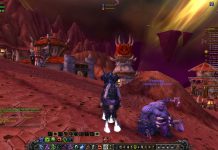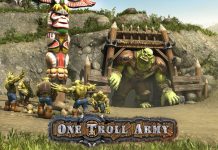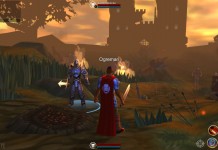Enter into the ancient age of feudal lords, warring states, and a lot of nifty wuxia Kung Fu—weapons flying, aerial battles, and people snaring at each other—it’s GamesCampus’s 3D free-to-play Chinese-history MMORPG 9 Dragons. The game is published by GamesCampus and developed by Joonwong Games (a Korean studio)–and it’s been with us a few years, but remains a little bit popular with its following fans.
Set in China during the Ming Dynasty, it includes actual Chinese geography and historical features such as the Great Wall of China and the famous Shaolin Monastery. According to Wikipedia, the original In-game story for the Korean version was written by wuxia novelist Jwa Baek; and it was localized for Western audiences when Acclaim hired Steven-Elliot Altman to rewrite the game in its entirety.
As 9 Dragons has been on the marketplace since 2010, the graphics will feel a bit outdated to many as will the UI. The community has dwindled somewhat and there’s not many from the Western audience still remaining in the game. However, that doesn’t mean that I ran into nobody playing—and add in the Chinese historical motif it has some interesting elements going for it.
I spent a little while in game to see how it plays and bring back my experience so you can decide if you want to try it out. Overall, it’s a game with some rough edges, but it has a nostalgic feel and a sense of art and style that might make it interesting—but for Western audiences or people who’ve gotten to particular MMO UI styles it might rub them the wrong way.
The security measures cooked into the game client can be a little bit overwhelming, if not obstructive. Not only must I use my usual username/password (to which most gamers are quite accustomed) but the game defaults to requiring me to use the on-screen keyboard to enter the last 3 characters of my password and then requires that I recall a special 4 digit PIN chosen at account creation.
Let’s see how it plays.
Graphics and Sound: Although simple in graphics, there’s an obvious art style going on here
Character generation was extremely simple, a few hair styles, colors, faces…choose a gender, and viola: out pops a smartly dressed vagabond ready to do Kung Fu in 9 Dragons. Not exactly the most customizable experience, with a fairly simple-looking avatar, but what it lacked in fine detail, it made up for in textured detail with interesting clothing, Chinese-appearance hairstyles, and a good fit for expectations of someone who doesn’t know too much about ancient China (the setting of the game.)
The graphics for this game have this sort of muddy watercolor effect even at the highest quality settings, as if I’m looking at a 3D painting in low polycount. The vegetation in particular looks slightly off when compared to the models for the people and buildings; although I did enjoy the speedy clouds whisking by in the skybox overhead.
The character models themselves feel low poly, and also look like fabric paintings to an extent—but what sets them apart is their costuming. The game is supposed to be set in the mythic history of ancient China and that’s also where much of the game gets its skill jargon from Kung Fu to the names of various clans and even the names of NPCs. As a result, to most Westerners it will have a sort of exotic theme, and in a way the art-style helps fixate that.
Chatting with NPCs places them large on one side of the screen with a tall scroll with text on the other for mission briefings and other information.
The fighting aniamations are amusing enough and seem to borrow a lot from Chinese martial arts movies and wuxia (as expected.) I rather like watching my character swing, swirl, and hammer with her staff as she sends splashes of light from a struck enemy, shouting, and hollering until she beats him into a quickly-vanishing-corpse. Of course, the loot doesn’t hurt either.
The UI has some effects that sound metallic.
The music is Chinese-sounding, mostly lilting flutes…but I’ve barely noticed it while playing. In fact, I’m not sure if the music is on a loop, if it comes and goes, or if it’s triggered by particular interactions with NPCs.
Gameplay: Click-to-move, click-to-attack, but Kung Fu and a bit of swiftly running around
The movement system is click-to-move (and no option appears to exist for WASD controls) combined with a hold mouse-button to move camera. Talking to NPCs can be a little bit weird because it require clicking them once to select them and then clicking them again to activate dialogue. As a result, I first thought I needed to double-click NPCs to interact. The underlying UI is intuitive enough but it lacks the subtlety of most modern MMOs on the user experience front; that said, the game does fit into the MMORPG model for windows, UI elements, and such so the learning curve for getting into the game is quite easy to overcome.
The click-to-move changes when you use one of the more amusing Kung Fu powers called “lightfoot” basically the spring in the game that allows swiftly moving from place to place. It is activated with ALT held down and when in that mode mouselook aims avatar direction.
Choosing a clan appears to lock in what weapon you’ll end up using, perhaps initially, and I chose to be part of the League of Beggars—who aside from being beggars, apparently are a spy and information network for the clans. This meant that my staff weapons would be the source of my Kung Fu. Clans also come with some restrictions, for example a female character cannot be a Shao Lin; and the Sacred Flower is the only clan with a woman as a clan leader.
The tutorial works out okay but it doesn’t smooth over all the kinks in the UI. For example, learning the different Kung Fu requires you to hit a training dummy, and you must also be in “Combat Mode” a little button at the bottom that switches between “Peaceful” and “Combat.” Also, I’m told hitting TAB switches it—just don’t hit TAB if the chat window is open. It’s easy enough to learn to turn that off, but it’s quite different from Western MMO UI conventions.
Even with the tutorial I found myself a little lost.
For example, the UI was suck that I couldn’t quite figure out why my staff would unequip (or move to a different slot.) The tutorial exists, hints exist, but they’re not very forthcoming in explaining how attack powers or Kung Fu works until you spend some time to examine what to click, why, and how.
Once learned, combat is still click-to-attack; it looks fluid, and it’s fun running around as I mentioned above, but it hurts immersion a little too much.
Some of the dialogue is hilarious, for example, during one of the first quests a Sacred Flower warrior calls a monk “that never-laid-man” after you ask her about his missing luggage.
Freemium: Pretty standard cash shop with aesthetic items and passes to far-away dangerous places
For a freemium model, 9 Dragons uses the GameCampus marketplace to sell players virtual items. The currency appears to be CC.
Much of the virtual item shop appears to be quality-of-life items, with boosts, and items that allow you to “keep options” when upgrading weapons. There’s also a section dedicated to aesthetic effects, including but not limited to swimsuits… Of course, I noticed that some of the aesthetic items also had time-limited items amongst them meaning that after spending money on them 15 days later they’d vanish.
Interestingly, there also seemed to be tickets or passes under the “Misc.” tab that would allow players entrance to either dungeons, realms, or instances that had extremely high levels attached. Suggesting that the game goes on for quite some time for exploration and generally getting into different content.
It’s hard to review the virtual item shop for its pay-to-win effects, but I didn’t see anything that jumped right out and said that this game has a pay-to-win problems.
Conclusion: The ancient Chinese motif is strong with this game but it’s not very Western-oriented
9 Dragons gets a little getting used to as a game, but I suspect that after extended play the UI and the odd approach to gameplay would grow on someone. For the purposes of review, I only play MMOs a few hours at a time and usually make it a little bit out of the newbie area. Underlying the user experience is a system that seems like it might be a complex customization method for Kung Fu and opening up new abilities and traversing the world.
After all, that lightfoot power feels awesome zooming across the countryside (it almost needs a cloud of dust behind players to make the effect perfect.) Add in the fact that it’s supposed to be set during the real Ming dynasty and have artifacts of that era visible in the game should draw more players in.
The server that I played on had a minimal population, but the people who were there did chat it up when messages came through. I suppose not many new players, since I didn’t see that many appearing in the beginning village.
The game has the hallmarks of a system that might work well if the UI could be cleaned up some to something that resembled a sleeker design. The guidance of the tutorial was nice for figuring out where to go and what to do, but I fell into a bit of a rut when the quest-system sent me on the umpteenth Fedex quest. I even beat up a few things (and leveled a few times) but without a better hook at the beginning, more opportunity, or perhaps scripted events 9 Dragons might fail to capture the attention of the attention-crippled modern MMO gamer.























A solid game, but to me, not much liked.